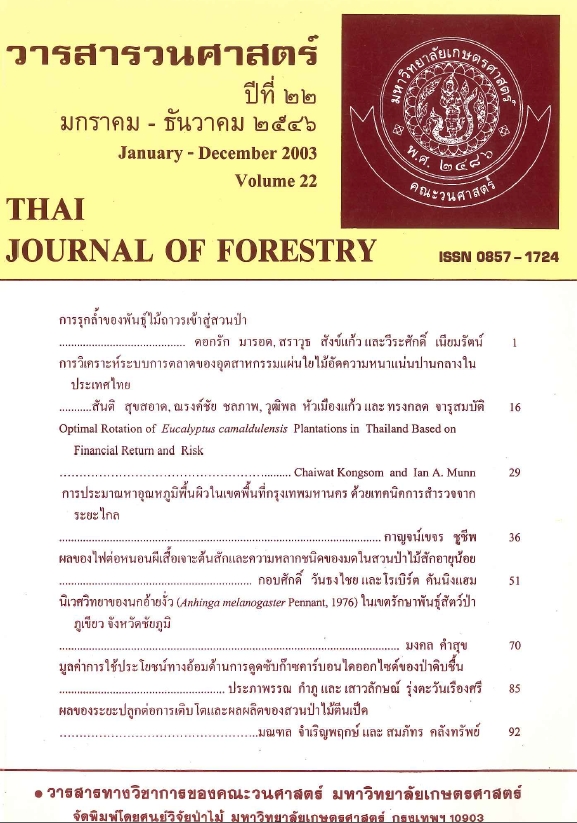SURFACE TEMPERATURE ESTIMATION IN BANGKOK METROPOLITAN USING REMOTE SENSING TECHNIQUES
Main Article Content
Abstract
Surface temperature of Bangkok Metropolitan and its surroundings were estimated using remote sensing techniques. The field measurement of surface temperature (TS) of selected objects was done to incorporate the digital number (DN) of Landsat Thematic Mapper (TM). Simple linear regression has been employed to prove the affect of DNs of each TM band on TS. The best-fit regression equation was derived. A number of DNs of TM band that affected significantly to TS have been measured systematically random. Measured DNs were input into the regression equation to estimate surface temperatures. Then, the estimated surface temperatures have been used to interpolate a SURFACE containing the value of surface temperature of the study area. Derived SURFACE was then used to generate the isoline of TS and incorporate to GIS data for describing the temperature phenomena of the study area. The results showed that DNs of the sixth channel of Landsat TM, had significantly affect on the surface temperature. The best fitted regression model was in form of exponential equation (with R2 = 0.707). SPLINE interpolator was suited for performing a SURFACE for this study. The surface temperature analysis indicated that the highest surface temperature of Bangkok, was found in the Bangkok Airport, was approximately 60.80 degree Celsius. In addition, the lowest temperature was found in Taling Chan district with 25.36 degree Celsius. It was also found that surface temperature was relatively high in the area covering with dense buildings and infrastructures. Meanwhile, agricultural lands located in the outer part of the Bangkok Metropolitan had concretely low surface temperature. The agriculture in form of standing trees had lower surface temperature than the agriculture in form of paddy fields or abandoned land. Results demonstrated that the differences in cooling and heating between the green area and building including infrastructure surfaces could affect city temperatures. Thus, urban forests would be important to keeping cities cool.
Downloads
Article Details

This work is licensed under a Creative Commons Attribution-NonCommercial-NoDerivatives 4.0 International License.
ข้าพเจ้าและผู้เขียนร่วม (ถ้ามี) ขอรับรองว่า ต้นฉบับที่เสนอมานี้ยังไม่เคยได้รับการตีพิมพ์และไม่ได้อยู่ในระหว่างกระบวนการพิจารณาตีพิมพ์ลงในวารสารหรือสิ่งตีพิมพ์อื่นใด ข้าพเจ้าและผู้เขียนร่วม (ถ้ามี) ยอมรับหลักเกณฑ์และเงื่อนไขการพิจารณาต้นฉบับ ทั้งยินยอมให้กองบรรณาธิการมีสิทธิ์พิจารณาและตรวจแก้ต้นฉบับได้ตามที่เห็นสมควร พร้อมนี้ขอมอบลิขสิทธิ์ผลงานที่ได้รับการตีพิมพ์ให้แก่วารสารวนศาสตร์ คณะวนศาสตร์ มหาวิทยาลัยเกษตรศาสตร์ กรณีมีการฟ้องร้องเรื่องการละเมิดลิขสิทธิ์เกี่ยวกับภาพ กราฟ ข้อความส่วนใดส่วนหนึ่ง หรือ ข้อคิดเห็นที่ปรากฏในผลงาน ให้เป็นความรับผิดชอบของข้าพเจ้าและผู้เขียนร่วม (ถ้ามี) แต่เพียงฝ่ายเดียว และหากข้าพเจ้าและผู้เขียนร่วม (ถ้ามี) ประสงค์ถอนบทความในระหว่างกระบวนการพิจารณาของทางวารสาร ข้าพเจ้าและผู้เขียนร่วม (ถ้ามี) ยินดีรับผิดชอบค่าใช้จ่ายทั้งหมดที่เกิดขึ้นในกระบวนการพิจารณาบทความนั้น”

